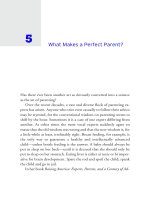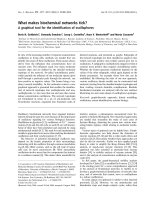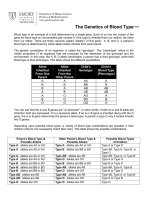Genetics of blood what makes up our blood
Bạn đang xem bản rút gọn của tài liệu. Xem và tải ngay bản đầy đủ của tài liệu tại đây (630.52 KB, 5 trang )
W
h
a
t
makes up our
b
l
oo
d
?
Did you
k
n
o
w
?
RED BLOOD CELLS (Erythrocytes) – T
e most abundant cells in our
The average adult has about five liters of
blood; they are produced in the bone marrow and contain a protein
called hemoglobin that carries oxygen to our cells.
blood inside of their body, which makes
up 7-8% of their body weight.
WHITE BLOOD CELLS (Leukocytes) – They are part of the immune
Blood is living tissue that acts as a
system and destroy infectious agents called pathogens.
PLASMA – This is the yellowish liquid portion of blood that contains
transportation sy tem in our bodies. It also
fights against infection and helps heal
electrolytes, nutrients and vitamins, hor
proteins such as antibodies to fight infectio
ones, clotting factors, and
.
wounds.
There are about
ne billion red blood cells
PLATELETS (Thrombocytes) – The clotting factors that are carried in
the plasma; they clot together in a process called coagulation to seal a
wound and prevent a loss of blood.
in two to three drops of blood. For every
600 red blood cells, there are about 40
platelets and one white cell.
G
e
n
e
t
i
c
s
of
B
l
oo
d
Your blood type is established before you are
born, by specific genes inherited from your
parents.
These two genes - one gene from your mother
and one from your father - determine your
blood type by causing proteins called
agglutinogens to exist on the surface of all of
your red blood cells.
There are 3 alleles or genes for blood type:
A, B, & O. Since we have 2 genes, there are 6
possible combinations: AA, AO, BB, BO,
AB, and OO.
Give the genotype(s) for each blood type.
Type A =
Type B =
Type AB =
Type O =
T. Trimpe 2009 h
tt p:
// s c
i e
n ce
s po
t .ne
t/
s
o
h
m
n
W
h
a
t
is the
Rh (Rhesus)
f
a
c
t
o
r
?
A certain blood protein was discovered while
studying Rhesus monkeys. The presence of the
protein, or lack of it, is known as the Rh factor.
Rh Blood Has the protein
Rh Blood Does not have the protein
Who can give you
bl
oo
d
?
People with Type O blood are called universal
donors, because they can give blood to any
blood type. People with Type AB blood are
called universal recipients, because they can
receive any blood type.
Fill in the diagram with the correct blood types.
Rh + Can receive + or
-
Rh
-
Can only receive
-
Blood
T
y
p
e
s
TYPE DISTRIBUTION
RATIOS
O + 1 person in 3
38.4%
O - 1 person in 15
7.7%
A + 1 person in 3
32.3%
A - 1 person in 16
6.5%
B + 1 person in 12
9.4%
B - 1 person in 67
1.7%
AB + 1 person in 29
3.2%
AB - 1 person in 167
0.7%
h
tt
p
: / /
www .
b
l
oo
d b o o
k .
c
o
m
/ t
y p
e
-
f
ac t
s .
h
t
m
l
T. Trimpe 2009 h
tt p:
// s c
i e
n ce
s po
t .ne
t/
A
s
m
a
ll
poo
l
of
b
l
ood
and a
weapon was
f
ound
near
a
garbage dumpster.
A
f
t
e
r
e
x
a
m
i
n
i
ng
the area, the
C
S
I
on
the
scene
d
i
s
c
o
v
e
r
e
d
a
body
i
n
the
g
a
r
b
a
g
e
dumpster
and
i
d
e
n
t
i
f
i
e
d
h
i
m
as
Earnest
“
O
n
e
-
E
y
e
d
”
E
a
r
l
.
E
a
r
l
had a
wound
t
o
h
i
s
chest that
will
be
a
n
a
l
y
z
e
d
by the
m
e
d
i
c
a
l
e
x
a
m
i
n
e
r
.
The
C
S
I
tested
b
l
ood
s
a
m
p
l
e
s
f
r
o
m
the
b
l
ood
poo
l
and
the weapon at the
c
r
i
m
e
scene.
It
was
d
e
t
e
r
m
i
n
e
d that
it
was human
b
l
ood,
but
he needs
to know
t
h
e
b
l
ood
type to
h
e
l
p
i
d
e
n
t
i
f
y
if it
was
f
r
o
m
the
v
i
c
t
i
m
or the person who
m
u
r
d
e
r
e
d
h
i
m
.
He
has
i
d
e
n
t
i
f
i
e
d
three suspects that
e
i
t
h
e
r
knew the
v
i
c
t
i
m
or were
seen
i
n
the area
b
e
f
o
r
e
the body was d
i
s
c
o
v
e
r
e
d.
He
w
ou
l
d
li
k
e
to
qu
e
s
t
i
on
them
f
u
rt
h
e
r
w
h
il
e
he
w
a
i
t
s
for DNA
test
r
e
s
u
l
t
s
.
Blood Typing Lab Activity
Complete the chart using the class notes.
Clumping = +
(Positive)
No Clumping = -
(Negative)
Type
Reacti ns w/
Anti-A Serum
Reactions w/
Anti-B Serum
A
B
AB
O
Rh Serum = Clumping = Rh+
blood
Lab Results - Follow your teacher's
directions to complete the lab.
Remember to be careful to prevent
cross- contamination of the blood
samples! Record the results (+ or -) from
each group in the trays below.
S
u
s
p
e
c
t
#
1
:
B
o
b
b
y
“
B
a
b
y
”
B
r
o
o
k
s
S
u
p
e
c
t
#
3
B
a
r
b
i
e
“
D
o
l
l
”
J
o
n
e
s
o
A
Rh
B
A
Rh
B
Type
A
Rh
B
A
Rh
B
Type
Type
V
i
c
t
i
m
Ernest
“One-
Eyed”
Earl
Crim
e
Scen
e
Sam
ple
Weapon
Sample
A
Rh
B
A
Rh
B
Type
What do your results show?
What should investigators do next?









